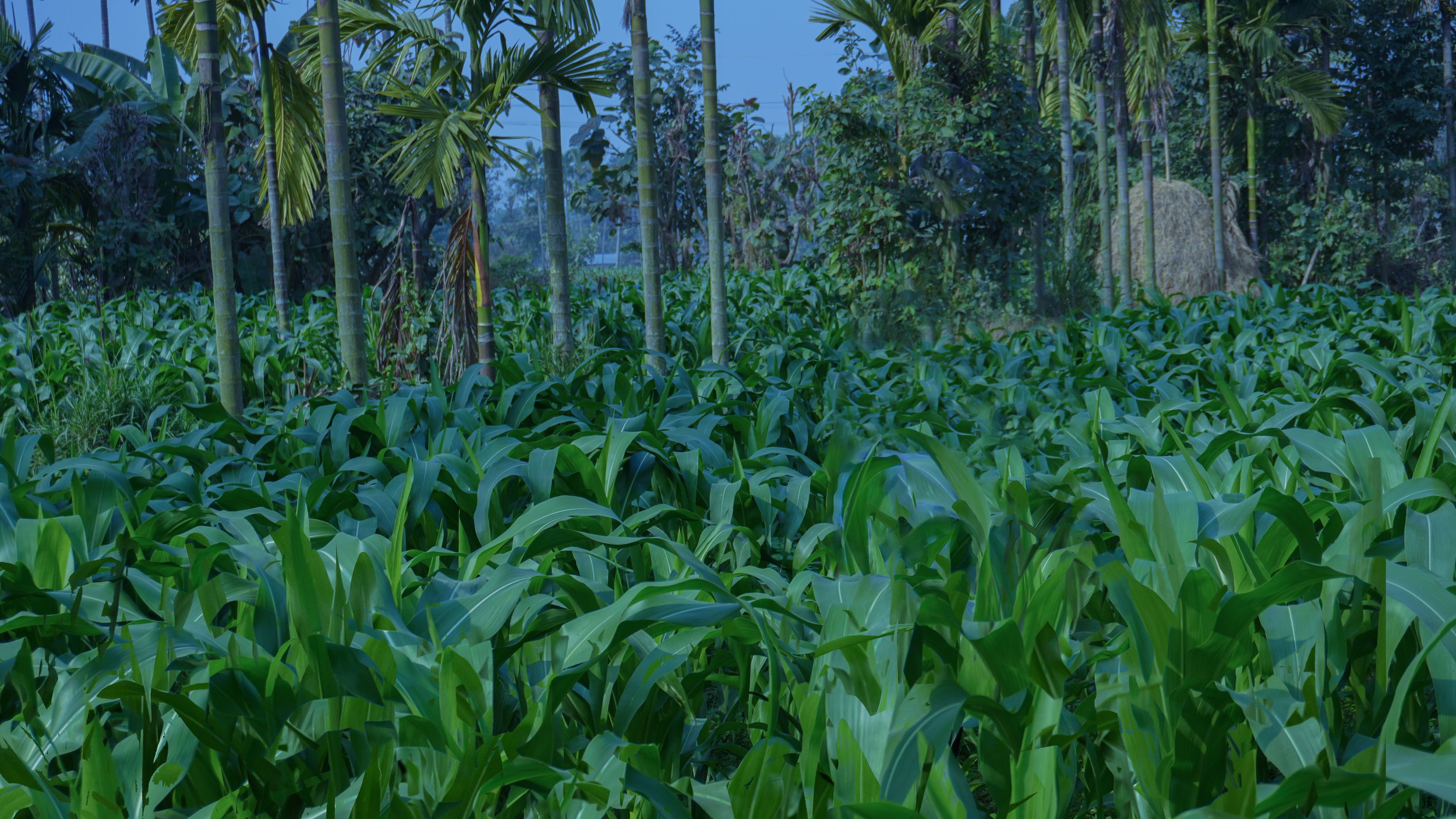
Multi-layer farming systems
Irrigation constrained diversification
Overview
The pathway of multi-layer farming in the villages of A Gaun and D Gaun in Jhapa District aims to implement multi-layer farming with betel nut as the existing primary crop to increase resilience against crop damage by wild animals. The introduction of betelnut as an ornamental crop in the 1970s has evolved into a key element of local agriculture, with some farmers successfully integrating it into their farming systems. The expansion of betelnut cultivation, partly driven by human-animal conflict—particularly with elephants—has encouraged farmers to plant these trees in various settings, including tea gardens. Many farmers have begun experimenting with multi-layer farming systems, thus existing betelnut plantation provide opportunities for multi layer farming with other crops such as black pepper (golmarich), teak, and fruits like banana and litchi. Despite these efforts, the practice remains poorly organized, and there is a need to streamline and improve the management of these multi-layer systems for better productivity and resource efficiency. This pathway justifies itself as a means to make better use of available land, diversify income sources, and reduce the negative impacts of fallow periods in the agricultural cycle, all while promoting environmental sustainability and improving local livelihoods.
Who is working in the Pathway
The partners for the implementation of this pathway include Nepal Multipurpose Cooperative Society Limited (NMC-COOP), Ministry of Industry, Agriculture and Cooperatives, Koshi Province (MoIAC), Agriculture Knowledge Center Jhapa (AKC), Local Government (Bhadrapur Municipality), and Nepal Supari Kheti Bikas Sanstha (NSKBS) which will serve as an advisory institution.
Activities
Activities Planned for this Pathway
Field survey/data collection: Conduct surveys to understand the potential and challenges of multi-layer cultivation, gathering essential data from farmers.
Package of Practice (PoP) for multi-layer cultivation: Collect data and develop a structured PoP for implementing successful multi-layer farming practices.
Support for crop variety selection and nursery establishment: Assist farmers in selecting appropriate crop varieties and establish nurseries through field surveys, data collection, and the formation of farmer groups.
Demonstration of three-layer farming: Demonstrate three-layer farming techniques at selected sites with two farmer groups in 2024 to showcase the benefits and practical implementation.
Expert visits and farm discussions: Organize visits by AKC and other experts to all participating farms, followed by meetings and discussions to provide guidance.
Soil testing: AKC will conduct soil testing for 22 farmers to ensure the suitability of the land for multi-layer farming.
Exposure visits: Facilitate visits to successful Indian multi-layer farms to expose farmers to advanced techniques (not currently possible through AKC).
Linkages between processing industries and producers: Organize discussions among NSKBS, PMAMP, and traders to create connections between farmers and processing industries, improving market access.
Learning about crop cycles and intercropping practices: Educate farmers on crop cycles and intercropping methods to optimize land use and production.
Support for irrigation technology and management practices: Assist farmers in selecting and implementing appropriate irrigation systems and management practices for multi-layer cultivation.
Harvest and post-harvest management: Provide guidance on best practices for harvesting and managing crops after harvest to reduce losses and increase profitability.
Regular technical mentoring: Ensure continuous support from experts to guide farmers through challenges and optimize farming practices.
Land preparation support: Offer assistance to farmers in preparing land for multi-layer farming, including technical advice and physical help if necessary.
Subsidized seedling distribution: Provide subsidized seedlings to farmers to help them establish their multi-layer farms.
Coordination with government: Facilitate coordination between local and national government bodies to streamline implementation processes and ensure the success of the project.
Partnership/facilitation in cost/investment: Work with partners to support farmers in cost-sharing or securing investments for the multi-layer farming system.
Results for each year – achievements and what we have learned
In year 1, significant progress was made in implementing the multi-layer cultivation pathway. Exposure visits were organized to observe three-storeyed cultivation in similar agro-ecological areas, with one visit successfully completed in the Bahundangi area, facilitated by AKC. This provided valuable insights into best practices and successful implementation strategies. Additionally, coordination between different levels of government was strengthened, with active involvement from both AKC and NMC, ensuring smoother implementation of the pathway. AKC and experts conducted visits to all participating farms, engaging in discussions on crop selection and offering tailored recommendations based on domain-specific knowledge. This hands-on support helped to refine the crop choices for each farm, aligning with the local environmental and economic conditions. Furthermore, farmer groups were formed through community-level interactions, with 22 farmers (11 in each of the two groups) joining the initiative. This collaborative approach fostered greater engagement and knowledge-sharing among farmers, contributing to the collective progress of the pathway.

Case Study Report
Areca-nut based Multilayer Farming
Farm Household Livelihood Diversification: Trade-offs & Synergies

